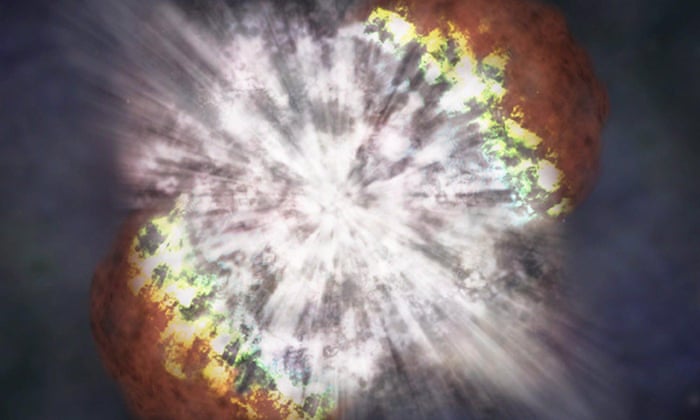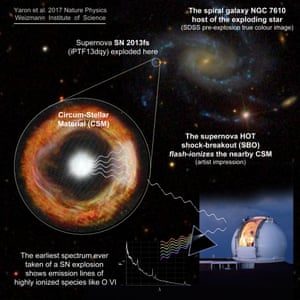
California observatory spots dying star 10,000 times brighter than the sun before explosion in a spiral galaxy 160m light years from constellation of Pegasus
Astronomers have captured the early death throes of a massive star that was torn apart in a violent explosion in a galaxy far from Earth.
The star was already 10,000 times brighter than the sun when it collapsed in a supernova that made it shine so intensely it was visible from modern telescopes in orbit and on the ground.
Using an observatory on Palomar Mountain near San Diego, California, scientists spotted the brilliant flash of the explosion within three hours of it reaching Earth. They immediately alerted other telescope operators who swiftly turned their instruments on the stellar wreckage.
Thought to be a red supergiant more than 10 times the mass of the sun and several hundred times larger, the star detonated in a spiral galaxy named NGC7610 which sits 160m light years away in the constellation of Pegasus.
It is the first time that astronomers have measured light from a supernova in its infancy, a feat that Norbert Langer, an astrophysicist at the University of Bonn who was not involved in the study, called “a remarkable achievement”.
Measurements of the dying star show that it was shrouded in a 10bn-km-thick cloud of gas which formed when material equivalent to a thousand Earths blasted from the surface in the final year of the star’s lifetime.
“Until several years ago, catching a supernova a week after the explosion was regarded as early,” said Ofer Yaron, an astrophysicist who worked on the data at the Weizmann Institute of Science in Israel. “This is not the case any more.”
The first flicker from the stellar explosion was detected on 6 October 2013 by the Intermediate Palomar Transient Factory (iPTF). On seeing the flash, researchers sent an alert to other astronomers to take what recordings they could. One scientist, Dan Perley, used the Keck telescope in Hawaii to analyse light coming from the supernova within six hours of the explosion. Other telescopes joined in, as did Nasa’s Swift satellite, which captured x-rays and UV light from the event.
The data reveal that the explosion probably came from a red supergiant surrounded by a shell of material which had been ejected from the star over a few hundred days at 100km per second. When the star exploded this shell would have been obliterated as several suns’ worth of matter, including all of the elements forged in the star’s core, blasted outwards at 10,000km (6,200 miles) per second.
The observations, reported in Nature Physics, have handed astronomers their best view yet of the most violent events in the universe. In the future, they hope to capture supernova at even earlier stages, within an hour or less of the explosions happening.
Astronomers expect one star, on average, to explode in a galaxy every 100 years. But the most recent supernova observed in the Milky Way was spotted in 1604 by Johannes Kepler. Unless stars have been exploding on the far side of the Milky Way – where the light would be swamped by other stars – we are long overdue a supernova in our cosmic neighbourhood. That would be a boon for astronomers, if unsettling for the rest of us. “If you ask swimmers in the sea, they don’t want to see sharks. But if you ask divers, that’s all they want to see. It’s the same thing. We all hope there will be a supernova in the Milky Way soon,” said Yaron. “As long as it’s not too near.”



No comments:
Post a Comment